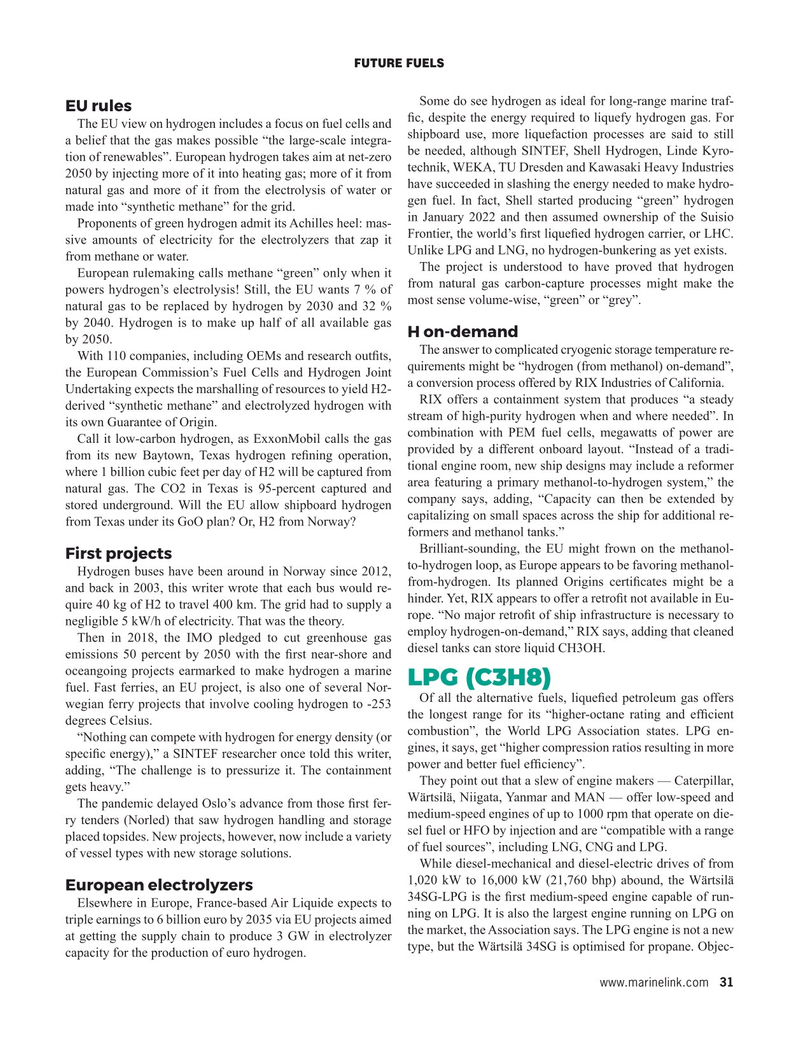
Page 31: of Maritime Reporter Magazine (May 2022)
Green Ship Technologies
Read this page in Pdf, Flash or Html5 edition of May 2022 Maritime Reporter Magazine
FUTURE FUELS
Some do see hydrogen as ideal for long-range marine traf-
EU rules ? c, despite the energy required to liquefy hydrogen gas. For
The EU view on hydrogen includes a focus on fuel cells and shipboard use, more liquefaction processes are said to still a belief that the gas makes possible “the large-scale integra- be needed, although SINTEF, Shell Hydrogen, Linde Kyro- tion of renewables”. European hydrogen takes aim at net-zero technik, WEKA, TU Dresden and Kawasaki Heavy Industries 2050 by injecting more of it into heating gas; more of it from natural gas and more of it from the electrolysis of water or have succeeded in slashing the energy needed to make hydro- gen fuel. In fact, Shell started producing “green” hydrogen made into “synthetic methane” for the grid. in January 2022 and then assumed ownership of the Suisio
Proponents of green hydrogen admit its Achilles heel: mas- sive amounts of electricity for the electrolyzers that zap it Frontier, the world’s ? rst lique? ed hydrogen carrier, or LHC.
Unlike LPG and LNG, no hydrogen-bunkering as yet exists.
from methane or water.
The project is understood to have proved that hydrogen
European rulemaking calls methane “green” only when it powers hydrogen’s electrolysis! Still, the EU wants 7 % of from natural gas carbon-capture processes might make the natural gas to be replaced by hydrogen by 2030 and 32 % most sense volume-wise, “green” or “grey”.
by 2040. Hydrogen is to make up half of all available gas
H on-demand by 2050.
The answer to complicated cryogenic storage temperature re-
With 110 companies, including OEMs and research out? ts, the European Commission’s Fuel Cells and Hydrogen Joint quirements might be “hydrogen (from methanol) on-demand”, a conversion process offered by RIX Industries of California.
Undertaking expects the marshalling of resources to yield H2-
RIX offers a containment system that produces “a steady derived “synthetic methane” and electrolyzed hydrogen with stream of high-purity hydrogen when and where needed”. In its own Guarantee of Origin.
Call it low-carbon hydrogen, as ExxonMobil calls the gas combination with PEM fuel cells, megawatts of power are provided by a different onboard layout. “Instead of a tradi- from its new Baytown, Texas hydrogen re? ning operation, tional engine room, new ship designs may include a reformer where 1 billion cubic feet per day of H2 will be captured from natural gas. The CO2 in Texas is 95-percent captured and area featuring a primary methanol-to-hydrogen system,” the stored underground. Will the EU allow shipboard hydrogen company says, adding, “Capacity can then be extended by capitalizing on small spaces across the ship for additional re- from Texas under its GoO plan? Or, H2 from Norway?
formers and methanol tanks.”
Brilliant-sounding, the EU might frown on the methanol-
First projects
Hydrogen buses have been around in Norway since 2012, to-hydrogen loop, as Europe appears to be favoring methanol- from-hydrogen. Its planned Origins certi? cates might be a and back in 2003, this writer wrote that each bus would re- hinder. Yet, RIX appears to offer a retro? t not available in Eu- quire 40 kg of H2 to travel 400 km. The grid had to supply a rope. “No major retro? t of ship infrastructure is necessary to negligible 5 kW/h of electricity. That was the theory.
Then in 2018, the IMO pledged to cut greenhouse gas employ hydrogen-on-demand,” RIX says, adding that cleaned emissions 50 percent by 2050 with the ? rst near-shore and diesel tanks can store liquid CH3OH. oceangoing projects earmarked to make hydrogen a marine
LPG (C3H8) fuel. Fast ferries, an EU project, is also one of several Nor-
Of all the alternative fuels, lique? ed petroleum gas offers wegian ferry projects that involve cooling hydrogen to -253 the longest range for its “higher-octane rating and ef? cient degrees Celsius. combustion”, the World LPG Association states. LPG en- “Nothing can compete with hydrogen for energy density (or gines, it says, get “higher compression ratios resulting in more speci? c energy),” a SINTEF researcher once told this writer, adding, “The challenge is to pressurize it. The containment power and better fuel ef? ciency”.
They point out that a slew of engine makers — Caterpillar, gets heavy.”
Wärtsilä, Niigata, Yanmar and MAN — offer low-speed and
The pandemic delayed Oslo’s advance from those ? rst fer- ry tenders (Norled) that saw hydrogen handling and storage medium-speed engines of up to 1000 rpm that operate on die- sel fuel or HFO by injection and are “compatible with a range placed topsides. New projects, however, now include a variety of fuel sources”, including LNG, CNG and LPG. of vessel types with new storage solutions.
While diesel-mechanical and diesel-electric drives of from 1,020 kW to 16,000 kW (21,760 bhp) abound, the Wärtsilä
European electrolyzers 34SG-LPG is the ? rst medium-speed engine capable of run-
Elsewhere in Europe, France-based Air Liquide expects to ning on LPG. It is also the largest engine running on LPG on triple earnings to 6 billion euro by 2035 via EU projects aimed at getting the supply chain to produce 3 GW in electrolyzer the market, the Association says. The LPG engine is not a new type, but the Wärtsilä 34SG is optimised for propane. Objec- capacity for the production of euro hydrogen. www.marinelink.com 31
MR #5 (18-33).indd 31 5/3/2022 9:21:01 AM

 30
30

 32
32
